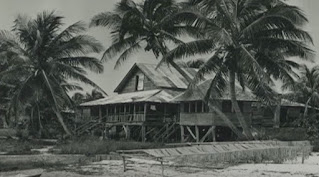Am posting a bit earlier than usual this month for time reasons. This post has updates about two places I've written in the past:
- One has a time element: The Mary S. Harrell Black Heritage Museum in New Smyrna Beach is having a heritage festival this Saturday - February 24, 2024. I hope you can make it.
- The other is about the former St. Benedict the Moor Catholic School in the Lincolnville neighborhood in St. Augustine. Many thanks to historian and author David Nolan for alerting me to the good news about a community project in development in that building. I hope you can support it.
 |
Mary S. Harrell Black Heritage Museum
(Photo credit: Peter Bauer) |
MARY S. HARRELL BLACK HERITAGE MUSEUM
The Black Heritage Museum is housed in the historic former Catholic church, St. Rita's, that served the Black community in the midcentury years of the 20th century. Those earlier days are the focus of my 2016 post.
Both past and present are featured in the excellent exhibits on view at the museum today. You can learn a great deal about the life and times of the community from its early days through today. Guided tours are part of the 31st annual Black Heritage Festival, which takes place from 9 a.m. to 6 p.m. February 24 in Pettis Park, adjacent to the museum building. Many other activities are also part of the festival.
Guided tours offer insights and context to exhibits that a visitor otherwise wouldn't know. I remember, during my visit, being shocked to learn that the community had protested the impending closing of their Black school during integration days. Shocked, because I had been taught otherwise, had been taught that Blacks applauded the school moves.
I was young during school integration days, and attending an already integrated Catholic elementary school in New York City. My (erroneous) knowledge was gained later, via the prevailing narratives taught in public high schools in my time. The older I get, the more I understand how much history contains nuanced and sub-surface levels, and shifting perspectives that depend on time and place of the telling.
Of course I digressed.... Try to attend the festival and tour and support the museum. You'll be glad you did.
 |
A blessing ceremony for a restoration and
transformation into a neighborhood center took
place at the former St. Benedict the Moor School
building. (Credit: First Coast News/Jessica Clark) |
ST. BENEDICT THE MOOR SCHOOL
I was again shocked - this time in a good way - to learn that the 1800s building that housed St. Benedict the Moor School in St. Augustine is being restored! When I wrote about the former school in a 2017 post, I wasn't even sure the actual building even stood any longer. I couldn't find any then-current photos of it.
So imagine my delight to learn that the Sisters of St. Joseph - who taught Black children at the school many decades ago - have launched a restoration project. Their goal is to restore the building and use it as a neighborhood center. Among other services, the St. Joseph Neighborhood Center will provide single mothers with education and job skills training.
First Coast News featured a January 2023 article about a blessing ceremony at the project site as restoration got under way. What the Sisters of St. Joseph need right now is your support to keep the ministry project moving forward. Learn more and donate via the St. Joseph Neighborhood Center's website. (And, fellow Catholics among readers, consider it a good way to boost your Lenten almsgiving.)
CLOSING THOUGHTS
I didn't plan this, but both my updates involve historic former schools in which Catholic sisters defied social norms by serving Black communities in a Jim Crow South. I know there are challenges that need fixing within Catholicism. But there is also so much good within the faith. Catholic sisters are past and present proof of that.




